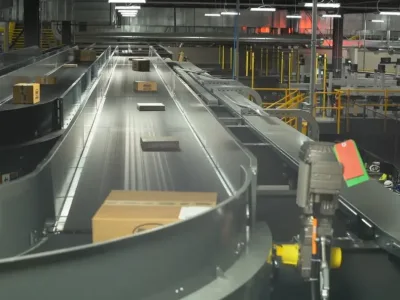
Mine engineers and geologists use digital terrain models (DTM) to determine production volumes and manage the movement of ore and overburden.
Because the mine landscape changes constantly, the best results come when measurements used to create the terrain (or surface) models are taken at regular intervals. The work to obtain this data is complicated by sheer size (large pit mines can be several kilometers across), difficult terrain, weather and safety concerns. The problems can be addressed by systems comprised of compact, low-cost unmanned aerial systems (UAS) together with new approaches for image processing and photogrammetry.
The measurements needed by mine engineers are traditionally obtained by terrestrial surveys or aerial imagery. Terrestrial measurements produce accurate results, but the technique is slow and the presence of surveyors on the ground can interrupt normal mine operations. Aerial imagery is less disruptive, but longer lead times and higher costs can force mines to take measurements only once or twice per year, which results in suboptimal data. A better solution comes in the form of small UAS, which can be dispatched on short notice and are less susceptible to weather.
A fixed-wing UAS such as the Trimble® UX5 Unmanned Aircraft System carries a high-resolution digital camera, GNSS navigation system, flight controls and communication equipment. Weighing roughly 2.5 kg and with a wingspan of one meter, the battery-powered UX5 can be carried and operated by one person. When on site, the operator defines and loads the flight plan into the aircraft’s onboard systems and then deploys and monitors the flight.
Flight planning is based on requirements for scale and resolution of the final data, which controls parameters including flight altitude above ground level (AGL) as well as along- and cross-path image overlap.
Launched from a small catapult, the aircraft autonomously executes the flight plan and collects images along specified flight lines before landing at a designated location. For projects that require multiple flights, the turnaround time to download images, upload a new fight plan, replace the battery and re-launch is roughly 10 minutes. The aircraft can operate for up to 50 minutes, with a cruise speed of 80km/h and a range of 60km.
Typical flight altitude is 75 to 200m AGL, based on project requirements and subject to local air safety regulations. While the UX5 operates autonomously, it is always in sight and radio communication with the operator. Automatic or user-initiated failsafe procedures can divert the UX5 to a safe landing in the event of changing conditions or loss of communications.

The Trimble UX5 UAS captures images over a quarry. The aerial solution can provide temporally dense imagery at low cost and minimal disruption to normal production activities.
The aircraft is equipped with a 24MP digital camera operating in RGB spectra. For applications in forestry or agriculture, it can be configured to operate in near-IR wavelengths. The camera produces ground resolution of 2.6 cm at 100 m AGL.
Digital images from the UX5 are processed using Trimble Business Center (TBC) software. Traditional photogrammetry calculations are based on the known location of the camera. But because the aircraft is moving rapidly during data capture, the raw images may contain significant geometric errors.
To correct this, the software adjusts the photo stations to remove error in location, orientation and camera calibration. The software first uses computer vision algorithms to identify common tie points in overlapping images. Then the photo stations undergo a simultaneous adjustment to produce a best fit over the complete project area.
With the photo stations resolved, the next stage is to connect the photographic models to the ground. Mines typically use a coordinate system that is tied to geodetic horizontal and vertical reference frames.
While the UX5 onboard GNSS system provides navigation and flight control, it is not sufficient for precise geo-referencing. Prior to the flights, ground control points are placed in locations where they can be readily identified in the photos. They are then observed using precise GNSS or optical survey instruments and methods.
These measurements are processed and adjusted in the Trimble Business Center to produce accurate coordinates in the designated geographic reference frame. Once the ground control targets are identified and registered in the photos, the software performs a final adjustment to produce georeferenced solutions for the photo stations.
For quality control, a subset of ground control targets is purposely omitted from the adjustment. The targets’ known positions can be compared to their positions derived from the imagery to confirm the overall accuracy of the solution. Using a desktop computer, the image adjustment is completed automatically and requires roughly 10 seconds per image, including refinement of the camera photo stations. The average re-projection error is roughly 1 pixel.
With the adjustment complete, the software uses conventional photogrammetric algorithms to compute the 3D coordinates of any pixel in an image. Typical deliverables include orthomosiacs, 3D digital surface models and point clouds. The surface models and point clouds are produced automatically based on user inputs for resolution and data density.
To provide additional detail, a raster digital surface model (developed from the generated point cloud) can be refined by using interpolation routines, noise filtering, edge modeling and outlier detection. The filtering algorithms are tuned to eliminate noise in the digital surface model while preserving small or subtle vertical features.
Mine engineers and geologists use 3D models to verify production quantities (comparing to truck counts and other methods) and to plan and design excavation and construction. These activities, common to mine operations, often require specialized analytic tools such as draping orthomosaics over the 3D surfaces as well as profiling, contouring, point cloud editing and volume computations.
By blending these functions with the rigorous photogrammetric computations, the Trimble Business Center software reduces overall time to result and reduces risks related to data transfer among multiple external packages.

The Trimble Business Center software produces orthographic images, point clouds and photorealistic 3D surface models.
Design information such as new excavations, slopes and haul roads can be loaded into computers onboard mine machinery. The georeferenced 3D data supports GNSS-based automated machine control for bulldozers, excavators and drilling equipment. The circle is closed when the UAS takes flight to measure the result of the next round of production and construction.
In addition to mining and earthworks, the combination of UAS and photogrammetric technologies is attractive in applications where frequent, high-resolution measurement of large or difficult-too-access areas is required. Industries including agriculture, energy, transportation, civil infrastructure and natural resources are looking with interest at the rapid emergence and adoption of unmanned solutions.
About the author:
Phil Sawarynski is Business Area Director of the Survey and Engineering
Geospatial Division at at Trimble – www.trimble.com
Related articles:
Parrot takes instant 3D mapping to the sky
Who owns the space above your garden?
Catcher drones to geo-fence industrial sites
 If you enjoyed this article, you will like the following ones: don't miss them by subscribing to :
eeNews on Google News
If you enjoyed this article, you will like the following ones: don't miss them by subscribing to :
eeNews on Google News



